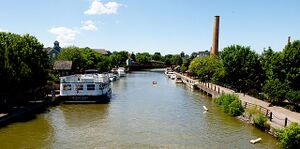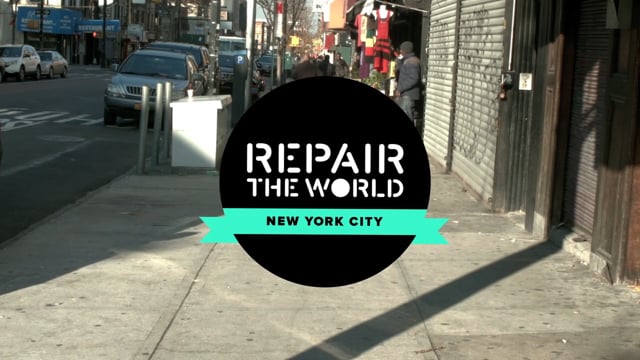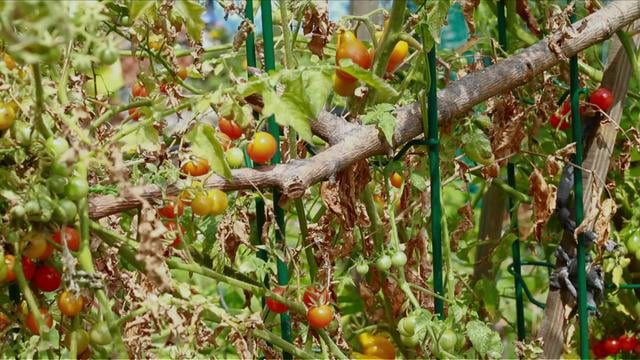
This article is an offshoot of New York City community action focusing on community resources and assets. Resources such as networks, events and community involvement (people and relationships) can be considered as primary resources. Also resources are the activism and physical assets (or what citizens value), such as green spaces and biodiversity, cycle lanes, etc, from the other NYC community pages.
Food activism NYC is a separate article.
Community energy[edit | edit source]
Energy efficiency
The city's uniquely high density, encouraged by much of it being surrounded by water, facilitates the highest rate of mass transit use in the United States. New York is one of the most energy efficient cities in the United States as a result. Gasoline consumption in New York is at the rate the national average was in the 1920s. The city's mass transit system, multifamily housing, mixed neighborhoods and the fact that greenfield land is no longer available to development, make building in New York very energy efficient. New York City has a larger population than all but eleven states, and consumes less energy per-capita than any. The average New Yorker consumes a little more than half of the electricity of someone who lives in Chicago and nearly one-quarter the electricity consumed by someone who lives in Dallas.
Nevertheless, New York faces growing energy demands and limited space. The city has introduced a series of environmental policies since the 1990s to address these problems. Detailed measures included switching more than 11,000 traffic lights and pedestrian signals in the city to new energy-efficient light-emitting diodes that use 90% less energy than conventional fixtures. The city replaced 149,000 "cobra head" street lights with new energy-efficient designs by 2008. Over 180,000 inefficient refrigerators in public housing projects have been replaced with new ones that use a quarter of the power of the old ones. By law, the city government can purchase only the most efficient cars, air-conditioners and copy machines. The electricity used to power the Statue of Liberty, Ellis Island and 22 other federal buildings in New York City, an annual electricity demand of roughly 27 million kilowatt hours, is provided by wind power.
New York City is home to several clean energy projects. Two attempts to provide electricity to Roosevelt Island by installing underwater turbines in the East River failed when the turbine blades were torn off by currents. An improved turbine design proved to be successful and on January 23, 2012 FERC issued a 10-year pilot commercial license to Verdant Power's RITE Project – the first commercial license for tidal power in the United States. Under the license, Verdant Power expects to generate up to 1 megawatt after a staged installation of up to 30 turbines. Planning is also underway to construct windmills on a hill in the former Fresh Kills Landfill. The wind energy project would power 5,000 homes on Staten Island. W
Energy efficiency and transportation
New York is distinguished from other American cities by its extensive use of public transportation. While nearly 90% of Americans drive to their jobs, public transit is overwhelmingly dominant for New Yorkers. According to the 2000 U.S. Census, New York City is the only locality in the United States where more than half of all households do not own a car (the figure is even higher in Manhattan, over 75%; nationally, the rate is 8%). About one-third of users of mass transit in the United States and two-thirds of the nation's rail riders live in New York and its suburbs, and New York City's public transit system accounts for nearly four times as many passenger miles as the Washington, D.C., and Los Angeles metro regions combined. Only 6% of shopping trips by New Yorkers involve the use of a car. Congestion pricing in New York City was approved in March 2024 and is expected to be implemented in June, pending the outcome of lawsuits. [needs update]
New York City's high rate of transit use saved 1.8 billion US gallons (6,800,000 m3) of oil in 2006 and $4.6 billion in gasoline costs. New York saves half of all the oil saved by transit nationwide. The reduction in oil consumption meant 11.8 million metric tons of carbon dioxide pollution was kept out of the air. The city's extraordinary public transit use means that New Yorkers emit far fewer greenhouse gases on a per capita basis than the average American. New York City's greenhouse gas emissions are 7.1 metric tons per person compared with the national average of 24.5. New Yorkers are collectively responsible for one percent of the nation's total greenhouse gas emissions though comprising 2.7% of the nation's population. W
Energy efficiency and Green building
For years New York City was slow to embrace green building guidelines used in cities like San Francisco to promote environmentally friendly construction. In the post-World War II construction boom, changes in zoning regulations and the widespread use of air conditioning led to the design of sealed glass and steel towers. Without natural sources of light and ventilation, such buildings required large amounts of fossil fuels to operate.
This phase of building style is rapidly changing in New York, which has become a leader in energy-efficient green office buildings like 7 World Trade Center, which recycles rainwater and uses it in toilets and for irrigation, and computer-controlled heating and lighting. The United States Green Building Council estimates 3,000 new green apartments in New York City have been built since 2001.
In 2000 the state of New York introduced a green building tax credit, the first one of its kind in the United States, that has allowed some developers of environmentally friendly buildings to write off as much as $6 million on their tax bill. The city's Department of Design and Construction developed a set of guidelines in 1999 that encourage environmentally sound building methods for municipal projects. The guidelines had led to approximately $700 million in green city construction projects by the end of 2005. In 2005, New York City mandated that nonresidential public buildings costing $2 million or more be built to standards set by Leadership in Energy and Environmental Design (LEED), which grade buildings in areas like energy and water consumption, indoor air quality and use of renewable materials. The legislation also applies to private projects that receive $10 million or more in public funds or half of whose budgets come from public money. W
Land activism[edit | edit source]
Reclaiming Vacant Land in New York City
In 2010, in Brooklyn, New York, Paula Segal started to gather information about a vacant space in her neighborhood. It was empty for years, collecting garbage. After some research, it appeared the vacant, fenced lot was public, and had been planned as a public park — which was never built. After several community meetings and exchanges with the municipality, Myrtle Village Green was born as a community space. It includes a research and production farm, meeting space, and an open-air cinema.
Based on this first experience, Segal and other activists wanted to find out how many such vacant public lots existed. It turned out to be 596 acres, which became the name of Segal's initiative. Over the past six years, the grassroots organization reclaimed, remixed, and opened to the crowd public data about vacant lots through its Living Lots map. The map offers information about each lot and gives an avenue to chat with neighbors interested in doing something with it. "New community gardeners are contacting us because they are using the Living Lots map to explore what city-owned land is potentially available for community gardening," says Carlos Martinez, deputy director of Green Thumb, New York's program for community gardening that emerged to support civic use of land left vacant by the city's fiscal crisis in the 1970s.
However, the true strength of 596 Acres lies not only online: The organization also puts up signs calling neighbors to seize the land for their community. And it works. It has spurred the creation of 32 community gardens on previously vacant public land mostly in underprivileged neighborhoods that lack parks and community facilities. Another reason for the success of the organization lies in the productive relationship it has with local agencies for urban gardening: "With 596 Acres, we work closely with each other, they help us to find key people who have interest to be the steward or the leader of a community garden," says Martinez. As of January, more than 848 acres of vacant public land have been plotted on the map.[1]
- 596 acres, showing sites of potential community projects
Health and wellbeing[edit | edit source]
- Free online therapy for NYC teens, talkspace.com, added 15:27, 9 December 2023 (UTC)
Reduce, reuse, repair and recycle[edit | edit source]
Earth Matter is a nonprofit organization dedicated to reducing the amount of organic waste that enters the garbage stream in New York City. By creating the local infrastructure needed for composting and encouraging community participation in events and education programs, the organization has gone from strength to strength over the past decade.[2]
Sharing[edit | edit source]
Maps: SolidarityNYC
Community currencies activism[edit | edit source]
Community Connections TimeBank, Visiting Nurse Service of New York
Citizens data initiative[edit | edit source]
Maps[edit | edit source]
- Living Lots NYC
- DEP Green Infrastructure Program Map
- Vacant NYC, crowd-sourcing information about vacant buildings
- Farming Concrete, Harvest Map
- Garden Geography: NYC community gardens in 2009/2010
- NYC Street Trees by Species
- Privately owned public spaces, Mapping New York's hidden gems, how crowdsourcing is taking the city back, guardian.co.uk, Nov 2011
- SolidarityNYC's map
Research[edit | edit source]
Farming Concrete is an open, community-based research project started by gardeners to measure how much food is grown in New York City's community gardens. Third and final NYC Harvest Report released in March 2013.
- The American Community Garden Association defines a community garden as "any piece of land gardened by a group of people." These spaces - peaceful enclaves where one can reconnect with their soil, food, and fellow gardeners - are meaningful across age groups and cultures, and serve as valuable assets for community identity. Healthy food production in community gardens is especially relevant today, when the number of New York City residents who rely on emergency food and lack access to affordable fresh produce in grocery stores is increasing. In the context of a dysfunctional food system, urban agriculture is becoming evermore indispensable.
- No one knows just how much food NYC community gardeners are growing. That is what this project seeks to measure.
- "In the tradition of all open source projects, our hope is that communities will be able to build upon what we've created–both software and methodology–to achieve their own goals."
See also
- Topic overview: Community resources, Community energy, Visions, Health and wellbeing, Citizens data initiative
- US context: Community resources USA, Community energy USA
References
- ↑ @Shareable
- ↑ Shareable Mar 19, 2019





